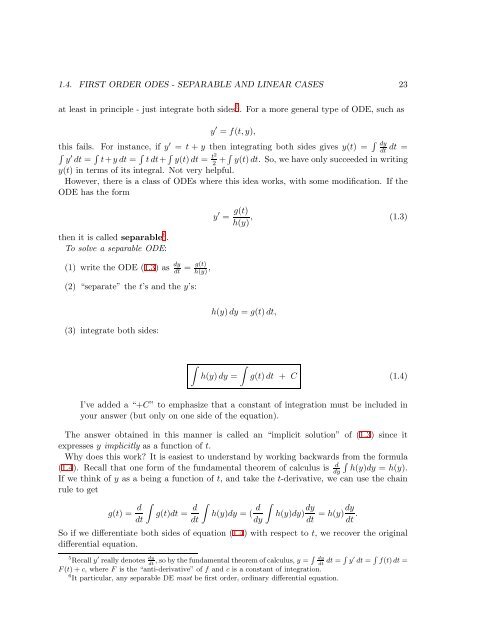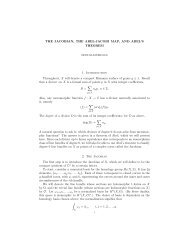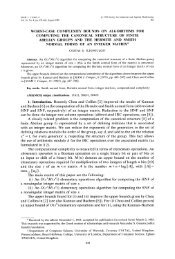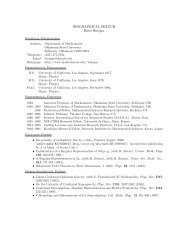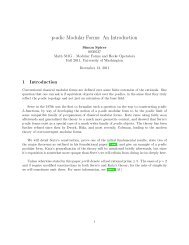Introductory Differential Equations using Sage - William Stein
Introductory Differential Equations using Sage - William Stein
Introductory Differential Equations using Sage - William Stein
You also want an ePaper? Increase the reach of your titles
YUMPU automatically turns print PDFs into web optimized ePapers that Google loves.
1.4. FIRST ORDER ODES - SEPARABLE AND LINEAR CASES 23<br />
at least in principle - just integrate both sides 5 . For a more general type of ODE, such as<br />
y ′ = f(t,y),<br />
this fails. For instance, if y ′ = t + y then integrating both sides gives y(t) = ∫ dy<br />
∫ dt dt =<br />
y ′ dt = ∫ t+y dt = ∫ t dt+ ∫ y(t)dt = t2 2 +∫ y(t)dt. So, we have only succeeded in writing<br />
y(t) in terms of its integral. Not very helpful.<br />
However, there is a class of ODEs where this idea works, with some modification. If the<br />
ODE has the form<br />
then it is called separable 6 .<br />
To solve a separable ODE:<br />
y ′ = g(t)<br />
h(y) , (1.3)<br />
(1) write the ODE (1.3) as dy<br />
dt = g(t)<br />
h(y) ,<br />
(2) “separate” the t’s and the y’s:<br />
(3) integrate both sides:<br />
h(y)dy = g(t)dt,<br />
∫<br />
∫<br />
h(y)dy =<br />
g(t)dt + C (1.4)<br />
I’ve added a “+C” to emphasize that a constant of integration must be included in<br />
your answer (but only on one side of the equation).<br />
The answer obtained in this manner is called an “implicit solution” of (1.3) since it<br />
expresses y implicitly as a function of t.<br />
Why does this work? It is easiest to understand by working backwards from the formula<br />
(1.4). Recall that one form of the fundamental theorem of calculus is d ∫<br />
dy h(y)dy = h(y).<br />
If we think of y as a being a function of t, and take the t-derivative, we can use the chain<br />
rule to get<br />
g(t) = d dt<br />
∫<br />
g(t)dt = d dt<br />
∫<br />
h(y)dy = ( d ∫<br />
dy<br />
h(y)dy) dy<br />
dt = h(y)dy dt .<br />
So if we differentiate both sides of equation (1.4) with respect to t, we recover the original<br />
differential equation.<br />
5 Recall y ′ really denotes dy<br />
dt , so by the fundamental theorem of calculus, y = R dy<br />
dt dt = R y ′ dt = R f(t)dt =<br />
F(t) + c, where F is the “anti-derivative” of f and c is a constant of integration.<br />
6 It particular, any separable DE must be first order, ordinary differential equation.


